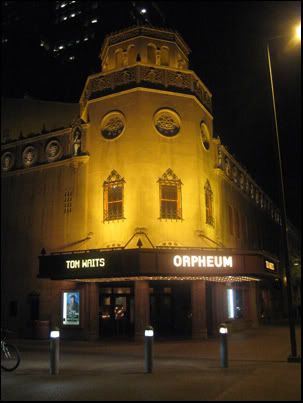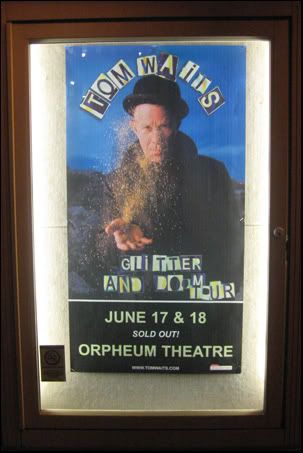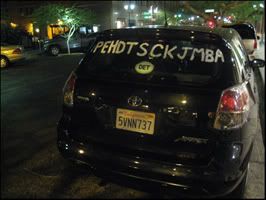

When Tom Waits tours, he doesn’t play in the Bay Area. You wanna see Tom Waits, you’ve gotta buy airplane tickets and fly somewhere else. And that, too, is fine by me.
So my friend Gerry and I flew 800 miles in 115-degree heat to see Tom Waits in Phoenix, AZ—his closest show—and we slept on the floor of the airport afterwards to catch a flight back home the next morning at 6am. Tickets: $100 each; airfare: $200 each; food and miscellaneous expenses: about $200.
Was it worth it? Completely.
Walking into the beautiful Orpheum Theatre on Wednesday night, we were met with marching drums, gongs, organs, and a ringside fight bell littering the stage. Hanging from the ceiling above were two huge, heavy sculptures of rusty bullhorns quietly emitting the sound of old 78s. And from the first to the last note, Waits commanded the room like a giant, slamming his feet on a dust-covered pedestal; punctuating each songscape with his stickman ballet; tumbling to the ground like an elastic wooden doll. His band was incredible—a six-ring ensemble who hauntingly conjured atmospheres more than they performed songs. I was literally on the edge of my seat, with my eyes wide open, through the entire show.
It’s gonna get interesting as the tour continues. According to people working on the inside, Waits and his band spent rehearsals at Zellerbach Hall in Berkeley running through over 65 songs in preparation for this tour.
But on Wednesday night, during a two-hour set, Waits offered a lopsided view of his majestic career. He played nothing at all from his Asylum years. Instead, he concentrated on material from Real Gone, his latest and most underwhelming album. When I came home from Phoenix and looked up the set list for the previous night, I wished I’d gone to that show instead. (But sweet Christ, at least I didn’t go to El Paso.)
The set list of an artist with zillions of songs is always a hard thing to accept. Shouldn’t we, as an audience, be happy with whatever the artist we avowedly love wants to play? I’ve seen plenty of prolific artists like Bob Dylan, Bruce Springsteen, Sonny Rollins, Guided by Voices, Frank Sinatra, A Tribe Called Quest—and because of their extensive recorded output, I’ve inevitably spent some time during the show wishing they were playing some other, and usually older, song. It might not be fair, but as a fan, I can’t help it.


Also, Tom Waits basically plays blues songs now. One-chord, stomping blues songs that just sort of chug along and don’t really go anywhere. Lots of white guys in their fifties immerse themselves in the “authenticity” of blues music, never to resurface—but if there’s anyone who can push past it, it’s Waits, and I hope that he does.
All of this I’d expected. So the show’s many highlights were a welcome surprise. “Cemetery Waltz” was unbelievable, as was a lower-register version of “Dirt in the Ground.” “November” came as a delightful rarity from The Black Rider, probably Waits’ most underrated album, and “Lost in the Harbour,” a poignant song from Alice, written around the same time, was beautifully performed on a reed organ.
Two songs gave me actual chills: “The Day After Tomorrow,” which I last saw performed (and cut short!) on The Daily Show (“my moment of zen”). Also, “A Little Rain,” which despite Waits’ new bassist Seth Ford-Young being slightly sharp throughout the entire song was still mesmerizing. Three cheers, too, for “All the World is Green” and “Hoist that Rag,” during which guitarist Omar Torrez thrilled with a dead-ringer Marc Ribot impersonation.
In other band news: Waits might be able to replace Ribot, but he sure can’t replace Ralph Carney. Saxophonist Vincent Henry proved an able accompanist, but man, his solos sounded like something from the Saturday Night Live band; just completely out of place. Casey Waits on drums was probably the biggest surprise—supremely tasteful and stylistically adaptable—and although Larry Taylor’s been Waits’ right hand man for decades on bass, Ford-Young’s tone and style is actually better suited to his material.
At times, Waits was his own best backing musician. During “16 Shells From a Thirty-Ought-Six,” he crashed his foot down in time onto a pedal, clanging the ringside boxing bell in time to the choruses. But between songs, his unfortunate accompaniment was the many rude and unintelligible shouts from the crowd. (Do hipster wannabes in vests and bowler hats annoy you? Do people shouting inane things like “You go, Tom!” in between songs annoy you? Be forewarned.)


TRENDING:











Funny You should say that. A lot of people liked what I played that particular evening, but I thought I sounded very Saturday Night Live-ish myself. Really. That was my first thought after each solo. Not really my normal approach. Oh well, all the best,
Vincent
hi Vincent, I wish you well on the tour, Tom just stopped calling me, maybe it was the turd in the punchbowl or something